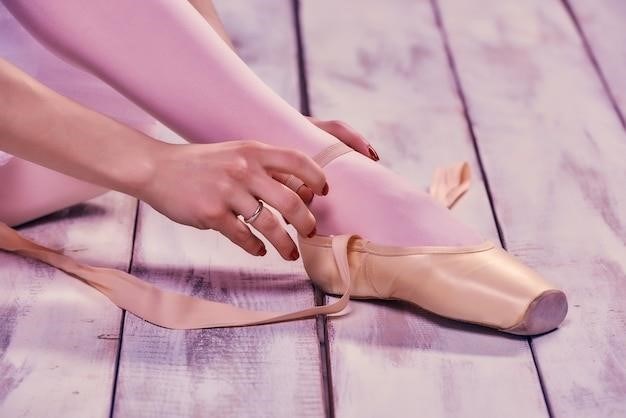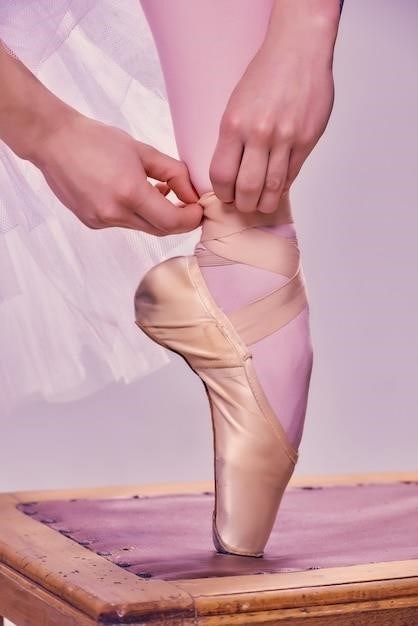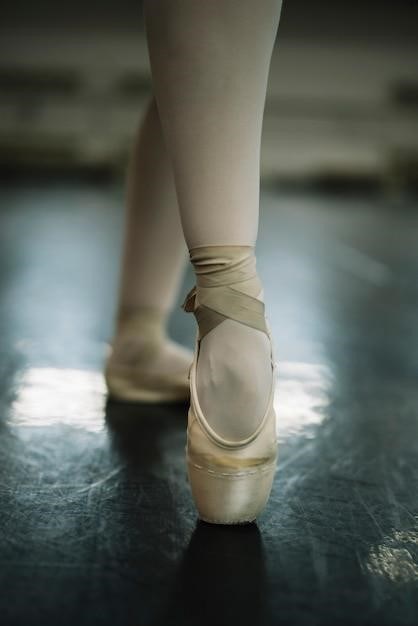Capezio Ballet Shoe Size Guide⁚ A Comprehensive Overview
This guide offers a detailed exploration of Capezio ballet shoe sizing, encompassing various models, addressing common fitting challenges, and providing valuable tips for achieving the perfect fit. Accurate sizing ensures optimal comfort and performance.
Understanding Capezio Sizing
Capezio, a renowned dancewear brand, offers a range of ballet shoes catering to diverse foot shapes and sizes. Their sizing system, while generally consistent, may present slight variations depending on the specific shoe model. Unlike street shoes, ballet shoes prioritize a snug fit, allowing for minimal movement within the shoe. This close fit enhances support, stability, and control during dance movements. Leather ballet shoes, in particular, exhibit a degree of stretch over time, adapting to the dancer’s foot. Therefore, initial tightness is often expected, gradually easing as the leather conforms to the foot’s shape. Understanding these nuances is crucial for selecting the appropriate size and ensuring a comfortable and supportive dance experience. Remember to consult Capezio’s size charts and consider professional fitting advice for optimal results. Pay close attention to both length and width measurements of your foot to make an informed decision.
General Sizing Recommendations for Women and Girls
For women, a common starting point is their regular street shoe size, progressing to a half size larger. The ideal fit should feel snug, with toes flat against the insole and positioned near the shoe’s end. This snugness is vital for support and control. Leather shoes will stretch slightly with wear, typically accommodating a half size increase. For girls, the recommendation often aligns with their regular street shoe size, potentially going up a half size for added comfort and room to grow. The same principle of a snug fit applies, ensuring the shoes provide adequate support without constricting the foot. However, individual foot shapes and widths can influence the ideal size, so personal fitting is recommended whenever possible. Consider that factors like foot width and the specific Capezio model can slightly alter the optimal size. Prioritize a comfortable fit that facilitates proper technique and prevents discomfort during dance.
Determining Your Correct Size Based on Foot Length
Precise measurement of your foot length is crucial for accurate Capezio ballet shoe sizing. Use a ruler or tape measure to determine the length of your longest toe from the heel to the tip. Ensure your foot is firmly planted on a flat surface for an accurate reading. Many online Capezio size charts correlate foot length (often in centimeters or inches) with corresponding shoe sizes. Refer to these charts to find the best match for your measurement. Remember that these charts serve as guidelines. Individual foot shapes vary, so some experimentation might be necessary. If your measurement falls between two sizes, it’s advisable to try on both sizes to determine which provides a more comfortable and supportive fit. Prioritize a snug yet not restrictive fit to prevent discomfort and blisters during dance. If possible, consult a professional fitter for personalized guidance. A proper fit maximizes comfort and enhances performance.
Capezio Size Charts⁚ A Detailed Breakdown
Capezio provides comprehensive size charts, typically available on their website and retail partner sites. These charts usually present size conversions across various systems, including US children’s sizes, US women’s sizes, and European sizes. They often include measurements in both inches and centimeters, allowing for a more precise fit. Pay close attention to the specific model of Capezio ballet shoe, as sizing can vary slightly between styles. Each chart will list the corresponding foot length for each size, enabling a direct comparison with your own measurements. Some charts might also account for width variations, offering options for narrow, medium, or wide feet. Always refer to the chart for the specific Capezio shoe model you intend to purchase, as sizing isn’t standardized across all their offerings. Using multiple reference points—foot length, US size, and European size—increases the likelihood of obtaining the correct fit.

Specific Capezio Shoe Models and Their Sizing
This section details sizing specifics for popular Capezio ballet shoe models like the 2037C Hanami Canvas Split Sole Ballet Slipper and others, highlighting potential variations.
Capezio 2037C Hanami Canvas Split Sole Ballet Slipper Sizing
The Capezio 2037C Hanami Canvas Split Sole Ballet Slipper is a popular choice for dancers of all levels. Accurate sizing is crucial for comfort and proper technique. While general guidelines suggest starting with your street shoe size or a half size larger, the 2037C may require more precise consideration. The provided size chart, though helpful, might not perfectly reflect individual foot shapes and widths. Remember that canvas shoes typically offer less stretch than leather. Therefore, measuring your foot length precisely is paramount. Consider factors like foot width and volume; if you have wider or fuller feet, you might need to go up half a size or even a full size to accommodate these dimensions. Don’t hesitate to consult a professional fitter for personalized guidance, especially if you’re unsure about your size. A proper fit will enhance your dancing experience and prevent potential foot injuries. Prioritizing comfort and support is essential for both beginners and experienced dancers.
Sizing for Other Popular Capezio Ballet Shoe Models
Capezio offers a wide range of ballet shoes beyond the 2037C Hanami, each with its own sizing nuances. Models like the Capezio Daisy 205 and others may exhibit variations in fit compared to the 2037C. Leather ballet shoes, for instance, tend to stretch over time, a factor to consider when selecting your initial size. Canvas shoes generally offer less give. Always refer to the specific size chart provided by Capezio for the particular model you’re interested in. These charts often include both US and international sizing, along with measurements in centimeters. Pay close attention to the manufacturer’s recommendations, as sizing can differ significantly across brands and even within a single brand’s product line. Consider the material, construction, and intended use of the shoe; factors that influence fit and comfort. Remember that a snug fit is essential, but excessively tight shoes can lead to discomfort and potential injury. If in doubt, seek professional assistance from a dance supply store specializing in fitting dance shoes.
Addressing Common Sizing Issues
This section tackles frequent problems encountered when selecting Capezio ballet shoes, focusing on half sizes, wide feet, and brand comparisons for optimal fit and comfort.
Dealing with Half Sizes and Wide Feet
Finding the perfect fit in Capezio ballet shoes can be tricky, especially when dealing with half sizes or wider feet. Many online resources suggest going up half a size from your usual street shoe size, especially for leather shoes which tend to stretch with wear. However, this is just a general guideline, and individual foot shapes vary considerably. For those with wider feet, going up a full size might be necessary to accommodate the extra width and prevent discomfort or potential foot injuries. Remember that a snug fit is crucial for support and proper technique, but overly tight shoes can restrict blood flow and cause pain. If you’re unsure, consulting a professional fitter is always recommended. They can assess your foot shape and recommend the most suitable size and width. Don’t hesitate to try on multiple pairs to find the perfect balance between a secure fit and comfortable space for your toes. Consider using thin socks during fittings to simulate the feel of wearing the shoes while dancing.
Comparing Capezio Sizing to Other Brands
It’s crucial to understand that ballet shoe sizing varies significantly across brands. While Capezio provides size charts, these shouldn’t be directly compared to those of other manufacturers like Bloch, Energetiks, or Sansha without caution. Each brand employs its unique sizing standards and lasts (the molds used to shape the shoes), resulting in inconsistencies. A size 7 in Capezio might not be equivalent to a size 7 in another brand. The length and width of the shoes can differ. Therefore, relying solely on a numerical size comparison across brands is unreliable. The best approach is to consult the individual size charts for each brand. Even then, trying shoes on is essential. Consider bringing your current well-fitting shoes of a different brand for comparison if possible. This hands-on approach ensures the most accurate fit for your feet, irrespective of brand-specific sizing variations.

Tips for Finding the Perfect Fit
Prioritize a snug fit, allowing for minimal movement. Remember that leather shoes will stretch slightly over time; this natural expansion should be considered when selecting a size.
The Importance of a Snug Fit
A properly fitted ballet shoe is crucial for both comfort and performance. A snug fit is essential to provide the necessary support and stability for various dance movements. Shoes that are too loose can lead to blisters, slippage, and potential injuries. Conversely, shoes that are excessively tight restrict blood flow and cause discomfort, hindering your ability to execute steps smoothly and gracefully. The ideal fit allows for a secure placement of the foot within the shoe while still allowing for some flexibility and natural movement of the toes. It’s important to remember that the fit should feel secure even when the foot is flat on the ground and the toes are pointed. The feeling of snugness should be comfortable, not painful or constricting, and this is especially important for the longer hours of rehearsal and performance. Therefore, finding that perfect balance between snugness and comfort is key to ensuring a positive dance experience.
How Leather Ballet Shoes Stretch Over Time
Genuine leather ballet shoes, a popular choice among dancers for their supple feel and durability, exhibit a natural tendency to stretch over time. This stretching primarily occurs across the width of the shoe, accommodating the dancer’s foot. The amount of stretch varies depending on several factors including the leather’s thickness and the frequency of wear. Regular use and the natural oils from the feet contribute to the gradual widening of the shoe. This characteristic is important to consider when determining the initial fit. It is advisable to select a shoe that feels snug yet not uncomfortably tight. The slight give in the leather will allow for a more comfortable and secure fit as the shoes conform to the shape of the foot. However, excessive stretching can compromise the shoe’s support, leading to instability during performance. Proper care and maintenance can help prolong the lifespan of leather ballet shoes and regulate the stretching process. Understanding this natural characteristic ensures a more informed selection of the right size from the start.
Additional Resources and Considerations
Consult online size charts and guides for further assistance. Seeking professional fitting ensures optimal comfort and support.
Utilizing Online Size Charts and Guides
Many websites dedicated to dance supplies offer comprehensive Capezio ballet shoe size charts. These charts typically provide measurements in both US and European sizes, often including details like foot length and width. Carefully review these charts, paying close attention to the specific model of Capezio shoe you intend to purchase, as sizing can vary slightly between styles. Cross-referencing multiple online resources can help confirm the accuracy of the sizing information. Remember that online charts serve as helpful guides, but individual foot shapes and preferences can influence the ideal fit. Don’t hesitate to contact the retailer’s customer service for clarification if you encounter any ambiguities or inconsistencies in the size information provided. Consider using a ruler to measure your foot length precisely to ensure you’re selecting the most appropriate size based on the chart’s recommendations. Always prioritize accuracy when referencing these charts to avoid ordering an ill-fitting pair of dance shoes.
Seeking Professional Assistance for Fitting
While online resources are valuable, seeking professional assistance for fitting Capezio ballet shoes is highly recommended, especially for beginners or those with unique foot shapes. Dancewear stores often employ experienced staff who can accurately assess your foot type and provide personalized fitting advice. A professional fitting ensures the shoes offer proper support and comfort, minimizing the risk of injuries and maximizing performance. They can guide you through the process of determining the correct size and width, accounting for factors like arch height and overall foot shape that online charts may not fully capture. Professional fitters can also advise on the appropriate style of Capezio shoe for your specific dance needs and skill level. This personalized attention can significantly improve your overall dance experience and prevent potential problems associated with poorly fitting shoes. Consider scheduling an appointment at a reputable dance supply store to receive expert assistance with your Capezio ballet shoe purchase.
